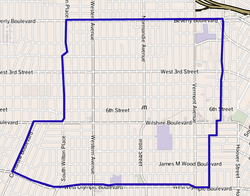Koreatown (Los Angeles)
| Koreatown | |
|---|---|
| Neighborhood of Los Angeles | |

City of Los Angeles Koreatown marker
|
|
| Nickname(s): "K-Town" | |
 Map of Koreatown as delineated by the Los Angeles Times |
|
| Location in Los Angeles | |
| Coordinates: 34°03′42″N 118°18′02″W / 34.0618°N 118.3006°WCoordinates: 34°03′42″N 118°18′02″W / 34.0618°N 118.3006°W | |
| Country |
|
| State |
|
| County |
|
| City |
|
| Government | |
| • City Council | Herb Wesson, David Ryu |
| • State Assembly | Miguel Santiago (D) |
| • State Senate | Kevin De León (D) |
| • U.S. House | vacant |
| Area | |
| • Total | 7 km2 (2.7 sq mi) |
| Population (2008) | |
| • Total | 124,281 |
| • Density | 16,451/km2 (42,609/sq mi) |
| Population changes significantly depending on areas included and recent growth. | |
| ZIP Code | 90010, 90005, 90020, 90006 |
| Area code(s) | 213 |
Koreatown is a neighborhood in Central Los Angeles, California, centered near Eighth Street and Western Avenue. Koreans began immigrating in larger numbers in the 1960s and found housing in the Mid-Wilshire area. Many opened businesses as they found rent and tolerance towards the growing Korean population. Many of the historic Art deco buildings with terra cotta facades have been preserved because the buildings remained economically viable for the new businesses.
It is the most densely populated district by population in Los Angeles County, with some 120,000 residents in 2.7 square miles. Despite the name evoking a traditional ethnic enclave, the community is complex and has an impact on areas outside the traditional boundaries. While the neighborhood culture has historically been oriented to the Korean immigrant population, Korean business owners are creating stronger ties to the Latino community in Koreatown. The community is highly diverse ethnically, with half the residents being Latino and a third being Asian. Two-thirds of the residents were born outside of the United States, a high figure compared to the rest of the city.
The 1930s saw the height of the area's association with Hollywood. The Ambassador Hotel hosted the Academy Awards ceremony in 1930, 1931, 1932, and 1934. Senator Robert F. Kennedy was assassinated in 1968 at Ambassador Hotel. About this time, the surrounding neighborhood began a steep decline. After most of the hotel structures were demolished, the Robert F. Kennedy Community Schools were built on the site with the first opening in 2009.
The once-glamorous mid-Wilshire area with vacant commercial and office space attracted wealthier South Korean immigrants in the 1960s. They found inexpensive housing and many opened businesses there. The relaxed federal immigration rules following the Immigration and Nationality Act of 1965 resulted in a growing immigrant community. Many of the Art deco buildings with terra cotta facades in the area were preserved because they remained economically viable with the new businesses that occupied the structures.
...
Wikipedia

